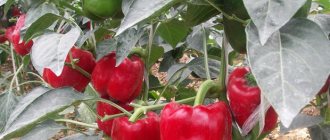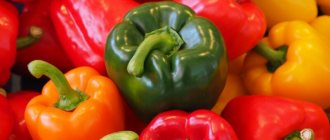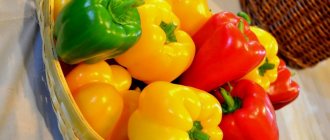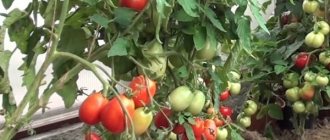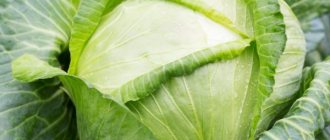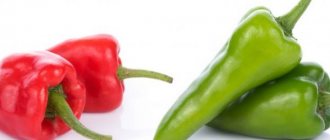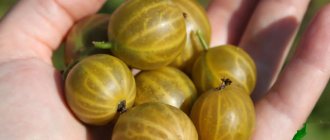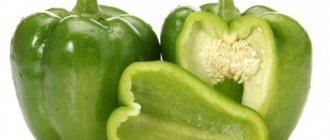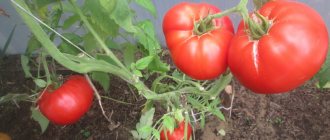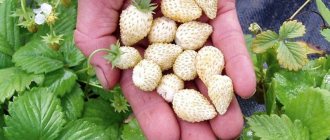What type of pepper is this?
Big daddy is suitable for growing in central Russia. Peppers are planted both in open beds and under film covers. It is unpretentious in care and has high and stable productivity.
Characteristics and description of the variety
The bushes of the variety are low-growing, maximum height 0.5 m. The leaves are small, round, with a slight purple tint. The variety is early ripening, ripens in 90-100 days from planting.
Fruit characteristics and yield
The fruits are small, cone-shaped. The weight of the vegetable varies from 100 to 120 g, the diameter is about 10-15 cm. The walls are of average thickness 5-7 mm. The color is dark cherry, the peel is smooth. The pulp is juicy and sweet in taste, which is why pepper is actively used in cooking. With proper care, gardeners with 1 sq. m they collect about 7 kg of tasty and beautiful fruits.
Interesting ! 100 g of bell pepper contains only 25 kcal. The vegetable is rich in fiber, iodine, fluorine and iron. B vitamins, which are found in large quantities in sweet peppers, help fight stress, prevent insomnia, and relieve fatigue. Vitamins P and C strengthen the walls of blood vessels and activate the liver.
Description and characteristics of the Big Papa variety
Moscow agro breeders worked on the creation of the Big Papa pepper variety. At the beginning of the 21st century, they developed a whole line of sweet bell pepper varieties called Big. Big Papa pepper differs from other varieties of this line in the unusual color of the fruit, thanks to which it looks very exotic in the garden.
Did you know? Just 40 g of sweet pepper contains the daily requirement of vitamin C for an adult.
Let's take a closer look at the characteristics of the Big Papa pepper:
- The plant is compact, the height of the bush does not exceed 50 cm.
- The stems are spreading and covered with a moderate number of large leaves that have a slight purple tint.
- The bushes bloom with small blue flowers.
- The variety belongs to the early ripening varieties. The harvest can be harvested 96–104 days after the appearance of green shoots.
- The fruits are cone-shaped and medium in size. Their length is about 8 cm, and their width is up to 5 cm. The vegetables are placed drooping on the stems.
- After reaching technical maturity, peppers are purple in color. Biological maturity occurs later, at this stage the vegetables acquire a dark cherry color.
- The weight of one pepper ranges from 90 to 120 g. The walls of the fruit are dense, up to 7 mm thick.
- Big Daddy peppers have a sweet taste and no bitterness. Ripe fruits are very juicy and have a pleasant aroma that persists even after heat treatment.
- The plant is immune to bacterial rot and tobacco mosaic.
Preparation for cultivation
Preparation for growing Big Daddy bell peppers consists of several procedures. Let's look at each in detail:
- Seed preparation. It is recommended to purchase seeds only from trusted stores, paying attention to the expiration date of the material and the integrity of the packaging. Seeds are disinfected at home by heating: place them on a baking sheet and put them in the oven for 40 minutes at a temperature of 180 °C. Another method of disinfection is soaking in a solution of succinic or boric acid. Disinfection destroys pathogenic microflora on the surface of seeds and protects seed material from diseases.
- Preparing beds in the garden. Pepper prefers sunny and loose beds. At the end of October, the ground is carefully dug up, getting rid of debris and plant remains. Feed with peat or humus, per 1 sq. m consume 1.5 liters of fertilizer. With the arrival of spring, the soil is dug up again, getting rid of leaves and large lumps. The beds are leveled with a rake and watered with liquid mullein infusion.
The best predecessors for planting peppers are onions, herbs or legumes. It is not recommended to plant peppers after tomatoes or potatoes. Compliance with the rules of crop rotation prevents the appearance of weeds and pests.
Reviews from gardeners
Seeds bred by the breeder Aelita are being chosen by more and more fans of unusual varieties of Bulgarian vegetables. Gardeners' opinions about the fruit are ambiguous - if not properly cared for, the cuboid shape is lost and becomes pointed. The walls become thin as a result of insufficient watering or depending on the climate zone. Loss of color in the marinade is also one of the disadvantages. Among the positive aspects of growing the Big Papa variety, they note the unobtrusive taste that reveals itself in salads. The crop is called successful for self-cultivation, but they emphasize the need to tie up the bushes. Knowing all the nuances of the plant, having studied its agricultural technology and culinary capabilities, it can be planted in a summer cottage or in a vegetable garden.
Article Rating
Growing seedlings
The seedling method speeds up adaptation to adverse weather conditions. It is prepared 50 days before planting the seeds in the ground.
Planting pepper
Plant peppers in any convenient container. These can be cut plastic bottles, thick bags and even eggshells. An excellent container for Big Daddy peppers is seedling boxes with drainage holes. They are made of wood or plastic. In the store it is not difficult to choose the size of the box that is suitable for a specific window sill. It is convenient to care for the sprouts in the box; all the seedlings are nearby. If necessary, all peppers are transferred to another place. The recommended height of the box is at least 8 cm.
The distance between seedlings should be at least 7 cm. Small grooves 1 cm deep are made in the soil using a pencil. 2-3 disinfected seeds are placed in each hole, sprinkled with earth on top and watered with warm water. To create a greenhouse effect, seedlings are covered with polyethylene or thin glass. Remove the shelter after 2 weeks, when the first shoots appear.
Seedling care
Sweet pepper seedlings need warmth and sunlight, so the best place for them is a windowsill. Care consists of timely watering and fertilizers. Water the seedlings once every five days; it is recommended to use warm water from the filter.
Cold tap water increases the risk of dangerous germs growing. Peppers are fertilized 15 days after planting. The first feeding is liquid organic matter, for example, bird droppings or mullein. The next time the seedlings are fed is another two weeks later. To accelerate growth, stimulants are used - the drugs “Kornevin” or “Heteroauxin”.
Important ! If the seedlings grow in small cups or pots, two weeks after planting they are plucked, that is, planted in a larger container. Picking gives the roots more space to grow and develop. The sprouts are carefully placed in a container with soil, sprinkled on all sides and patted down.
Big Boy
Scientists can joke after all! Therefore, they “gave birth” to the family with a dark burgundy son. Among other varieties of red pepper, the boy turned out to be large - each fruit is up to 300 grams, thick-walled - 8 mm.
- The baby is precocious (105 days before maturity).
- The pepper bush is of medium height and strong.
- Resistant to diseases, not fussy to care for. It is preferable to form two tables.
Boy peppers are elastic, juicy, not bitter, shaped like barrels. Perfectly stored and transported.
Planting in the garden and further care
10 days before planting in the garden, reduce the number of waterings, and stop completely a week. You can tell that peppers are ready for planting by their characteristic feature: the sprouts have 8-11 leaves and developed flowers. The best time for the procedure is early morning or evening, when there is no sun. The optimal distance between bushes is 50 cm - thick planting will lead to the development of diseases. The seedlings are watered abundantly, each bush is carefully removed from the container and placed in the prepared hole.
The basis of any plant care is regular and proper watering. The water temperature should be at least +20 °C; the beds should be moistened once every 5-7 days. About 1.5 liters of water are consumed per bush. The stream is directed directly to the root, bypassing the stems and leaves. This protects the bushes from fungi and viruses. Some summer residents install a drip irrigation system on their property. It is convenient because the water goes directly into the root system, while the moisture consumption is several times less than with manual watering.
It is impossible to grow a rich harvest without timely feeding and fertilizers. The procedure is carried out two weeks after disembarkation and then at intervals of 2-3 weeks.
To fertilize Big Daddy peppers use:
- solution based on dry wood ash;
- liquid mullein, urea, bird droppings;
- ammonium nitrate;
- superphosphate.
The best varieties of bell peppers for greenhouses
Miracle tree F1
The variety is tall, the bushes grow to a height of 1.8 cm. 3 months after planting, you can collect peppers from the tree; they are medium-sized, red, weighing about 100 g. The pulp is juicy, 6 mm thick. One large bush can grow up to 50 fruits.
Fat Baron
The variety will take root best in southern open soil, but in a greenhouse it can grow even in northern Russia. The bushes are not tall, but fruitful, so they even require garter. The fruits can be picked already green, but when biologically ripe they are red. The pepper is quite sweet, weighing up to 150 g with a pulp 6 mm thick. Perfect for preparing and eating fresh. Ripens in 4 months.
Pepper varieties can be considered for an infinitely long time, because now gardeners are presented with a large assortment for different growing conditions. When choosing seeds, you should rely on your own preferences and reviews of experienced summer residents. In addition, take into account the climatic conditions of your region so that the seedlings do not die during unexpected frosts.
Seeds of the best varieties of sweet peppers can be purchased at any garden store. When choosing, be sure to consider the purposes for which you will plant bell peppers: fresh consumption, canning, frying, stewing. You can plant several varieties on your site in order to determine the best variety for your family in the future.
Also read:
- Varieties of thick-walled sweet pepper for open ground
- How to grow perennial plants for your garden
- Onion varieties per feather
- The best varieties of tomatoes for 2021 - 2021 for greenhouses
- The most productive varieties of tomatoes for open ground
- Pepper varieties for polycarbonate greenhouses. When is it possible...
- We arrange beautiful flower beds ourselves and…
- Catalog of high-yielding cucumbers for planting in…
Features of cultivation and possible difficulties
Growing in a greenhouse has its own rules. Before planting, the walls of the structure are wiped with a solution based on potassium permanganate to destroy dangerous microbes . They begin to form a plant as soon as the stems branch. Only the powerful and strong are left, and the weak are removed.
It is recommended to monitor the amount of fertilizer applied. If the leaves turn yellow and become dry, it means that the gardener applied too much mineral fertilizer. If the plant gains growth and green mass, but does not bloom, this indicates an excess of nitrogen; dry and weak stems - excess phosphorus. Abundant watering with warm water and dusting the bushes with wood ash will help correct the situation.
Typical diseases and pests
If crop rotation rules are not followed, wireworms appear in pepper beds. The pest lives underground and feeds on the roots of the plant, causing it to stop growing. If measures are not taken in time, the bush itself begins to wither and the fruits become deformed. Professional products “Maxim” or “Oxychom” help to get rid of a thick brown worm.
In addition to wireworms, peppers are negatively affected by:
- Colorado potato beetles, the cause of which lies in contaminated soil. Beetles and their larvae can destroy the entire crop. They get rid of them using the drug “Typhoon”.
- Thrips appear at the stage of bush formation. They feed on plant juice and nectar, depriving them of nutrients for further development. For prevention, spray with Bordeaux mixture.
- Whiteflies —miniature white midges—gather in flocks on leaves. Sprays based on milk and iodine help in the fight against whiteflies.
Late blight poses a particular danger. The fungus appears due to excessive heat, temperature changes, and improper watering. Late blight appears in the form of yellow and brown spots on the leaves and stem. The fungus is dangerous both for open ground and for greenhouses. To combat late blight, spray with manganese or water with wood ash.
Advantages and disadvantages of the variety
The advantages of the Big Dad variety include a sweet and juicy taste, dense pulp, attractive and original appearance. Due to its small size, peppers are great for preparing stuffed appetizers and are used as an ingredient for winter preparations and pickles. The crop is grown in open ground or in greenhouses; caring for the vegetable does not require special knowledge and skills.
Interesting ! Bell pepper goes well with meat, fish and poultry, and harmonizes with the taste of other vegetables. A particularly original taste is obtained if you cook Big Daddy peppers on the grill. The vegetable will acquire a beautiful roasted appearance and a piquant aroma. You can cook peppers both at the dacha and at home, on a home grill. Aromatic spices and herbs, as well as balsamic or wine vinegar, will help add zest.
Minus: Big daddy is suitable for cultivation only in central Russia. In the conditions of the Urals and Siberia, pepper shows low yield. In addition, the vegetable has average immunity to diseases and pests.
Harvesting and application
The first harvest is usually carried out in early July when the vegetables reach technical maturity. This is necessary so that the bush has enough strength to grow another portion of fruits and ensure their ripening.
Important! At technical maturity, vegetables are purple in color, but during storage they ripen and can change to burgundy.
The second portion of ripe fruits is collected after they reach their biological maturity and acquire a dark cherry color. This must be done before frost sets in.
The collected vegetables can be used to prepare:
- fresh salads;
- hot dishes;
- frozen preparations;
- canned salads, snacks.
The Big Papa pepper variety will not only delight you with a bountiful harvest and excellent taste characteristics of vegetables, but will also decorate your garden bed thanks to its unusual color and beautiful shape of the fruit. To do this, it is enough to follow all the recommendations described above and take the necessary actions to prevent the occurrence of diseases and pests.
Reviews
What do other gardeners say about Big Daddy peppers? Here are a few reviews from popular online forums.
Alisa, Volgograd: “I love everything unusual, so I decided to plant a Big Papa pepper. The harvest exceeded all my expectations! I collected 10 kg of pepper from the garden! The whole family loved this beautiful dark cherry vegetable.”
Maria, Orel: “I’m planting the Big Dad variety for the third time. I prefer to grow it in a greenhouse to protect it from bad weather. The variety does not cause any trouble; there is no need to tie up or pluck the bushes. I use the harvest to prepare salads and side dishes, and freeze the remaining peppers for the winter.”
Pavel, Penza: “On the recommendation of a neighbor, I planted Big Daddy last year. I planted seedlings and observed all sowing dates. However, the peppers did not take root well in the garden and slowly gained weight and color. I was disappointed because I was hoping for a different result.”
Description of the variety
The originator of the pepper was Russian. The variety is recommended for cultivation in the stable climate of the middle zone - in the East and the Volga region. The coolness of the northern regions has a detrimental effect on the yield and taste of pepper. However, many gardeners quite successfully cultivate vegetables, smoothing out the effects of bad weather with the help of greenhouses.
Main characteristics:
- the bush is not tall, stopping at around 50 cm;
- the color of the leaves echoes the color scheme of the fruit - you can notice a purple tint;
- blue flowers;
- fruits with thick walls – up to 8 mm;
- There are up to 10 fruits per bush;
- The surface of the pepper is nasty, but the flesh is juicy.
Attention! There is a hybrid - its fruits are red in color and have good taste.
| Type of growth, bush height | Bushy 40-50 cm |
| Ripe fruit color | Violet |
| Planting scheme | 50x35 cm |
| Weight, length and shape of the fruit | Up to 100 g, 16-18 cm, cone-shaped |
| Ripening period, yield | Early ripening (90-100 days) In the greenhouse 7 kg/m2. In exhaust gas from 6 kg/m2 |
| Drop off point | exhaust gas/greenhouse/greenhouse |
| Diseases | Average immunity, susceptible to late blight |
| By type of use | Universal |
| Flowering type | Female |
